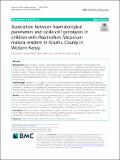Association between haematological parameters and sickle cell genotypes in children with Plasmodium falciparum malaria resident in Kisumu County in Western Kenya
Publication Date
2020Author
18. Kosiyo, P., Otieno, W., Gitaka, J., Munde, E. O., & Ouma, C
Metadata
Show full item recordAbstract/
Background: Sickle cell disease (SCD) is a monogenic disorder due to point mutation in the β-globin gene
resulting in substitution of Valine for Glutamic acid. The SCD is prevalent in P. falciparum endemic regions such as
western Kenya. Carriage of different sickle cell genotypes may influence haematological parameter during malaria.
Children resident in malaria holoendemic regions suffer more from malaria-related complications and this is
moderated by the presence of the SCD. In the current study, we determined the association between sickle cell
genotypes and haematological parameters in children with P. falciparum malaria resident in Kisumu County in
Western Kenya.
Methodology: Children (n = 217, aged 1–192 months) with acute febrile condition were recruited at Jaramogi
Oginga Odinga Teaching and Referral Hospital. Chi-square (χ2) analysis was used to determine differences between
proportions. Differences in haematological parameters were compared across groups using Kruskal Wallis test and
between groups using Mann Whitney U test. Multivariate logistic regression analysis controlling for infection status
was used to determine the association between sickle cell genotypes and haematological parameters.
Results: Using HbAA as the reference group, multivariate logistic regression analysis revealed that carriage of HbSS
was associated with reduced haemoglobin [OR = 0.310, 95% CI = 0.101–0.956, P = 0.041], reduced haematocrit
[OR = 0.318, 95% CI = 0.128–0.793, P = 0.014], reduced RBC count [OR = 0.124, 95% CI = 0.045–0.337, P = 0.001],
reduced MCHC [OR = 0.325, 95% CI = 0.118–0.892, P = 0.029], increased leucocytosis [OR = 9.283, 95% CI = 3.167–
27.210, P = 0.001] and reduced monocytosis [OR = 0.319, 95% CI = 0.123–0.830, P = 0.019]. However, carriage of
HbAS was only associated with increased micro-platelets [OR = 3.629, 95% CI = 1.291–8.276, P = 0.012].
Conclusion: Results show that carriage of HbSS in children influence the levels of haemoglobin, haematocrit, RBC,
MCHC, WBC and Monocytes. Therefore prior knowledge of HbSS should be considered to improve clinical
management of haematological alterations during malaria in children

